

The half-pyramid by Lego
The Lego Architecture series has gained a new member in the shape of one of the wonders of the world: the Great Pyramid of Giza. Structurally, it’s only mildly appealing. Structurally, however, it’s a stunner.
As a young boy, one of my dream jobs was to be an archaeologist and treasure hunter. Not surprising, if you’re raised on films including «Indiana Jones», «The Mummy» and «Lara Croft: Tomb Raider». Accordingly, my ageing wannabe archaeologist’s heart skipped a beat when I got my hands on Lego’s Great Pyramid of Giza. Although I never went on to study antiquity, building the 1476-piece Lego set makes me feel like that boy again – making great discoveries in an imaginary desert (i.e. my games room).

Building the pyramid stone by stone
The assembly of the diorama is divided into two stages. The bricks in bags one to four are used to build the base structure, the outbuildings and the bank of the Nile. Bags five to eight create the actual pyramid.
The construction process reminds me of early sets from the Architecture series. The base structure consists of large base plates, long bricks and tiles in various colours. At this point, the colours still have little in common with a pyramid in the desert, but I can already make out the shape of the diorama.
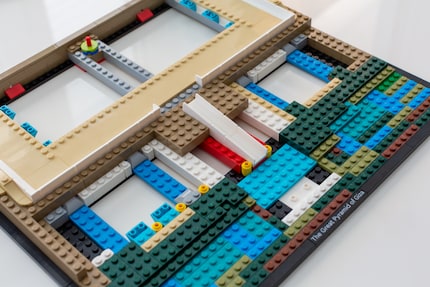
After the basic structure is in place, it’s time for the «front garden». On the left side there are two small pyramids, each containing a sarcophagus inside. On the right side, there’s a small village. The two «front garden» are separated by a white ramp and three sphinxes. The garden is lush thanks to a generous amount of subtropical plants in three different shades of green.
My highlight during this phase of construction is the Nile. The different coloured stones under blue-transparent tiles give the water visual depth.
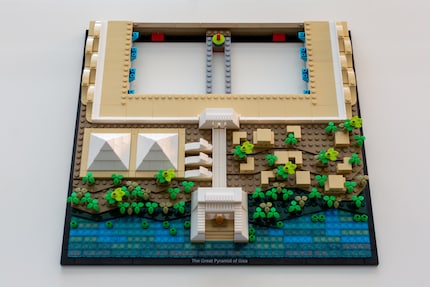
After assembling the front garden, it’s time for some real work: the big pyramid. Despite the mind-numbing task of stacking brown bricks, this building step was a pleasant surprise. Why? Because the pyramid is built as if it were still under construction. The set contains scaffolding and cranes. There’s also ramp from which you pull the top of the pyramid up with a winch. Although historians are still in the dark about how exactly the pyramids were built, it’s quite possible that this is what construction might have been like in the old kingdom.
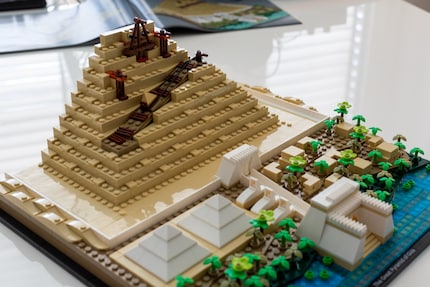
As a last step, I put up a removable white facade. Several white stones are stacked on top of each other like stairs and placed over the pyramid that’s under construction. The construction is large and hollow, so you can’t go in like a bull in a china shop. I occasionally apply too much pressure, which makes the odd step fall off. So I have to carefully put it back each time.
To conclude, I place two small sailing boats on the Nile and an obelisk in the village on the right. All in all, constructing the entire set took just under four hours.
Half-baked
To give you more than view of the exterior, the pyramid is cut in half. This reveals the chamber system inside the tomb. Similar to the original, there’s the large gallery, the royal chamber with a sarcophagus and several air shafts, to name but a few things. As with the construction of the Great Pyramid of Giza, many questions remain unanswered about the chamber system. Egyptologists suspect that the different rooms are of a religious nature. Unfortunately, there are hardly any written records from this period, so much of it remains a mystery. Maybe even forever.
If you don’t care much for the insides and would rather have a complete pyramid, you’ll have to buy two sets. They can be connected by two pins at the bottom of the diorama. If you want, you can also build one half of the pyramid without a lid and leave it in an «under construction» state.
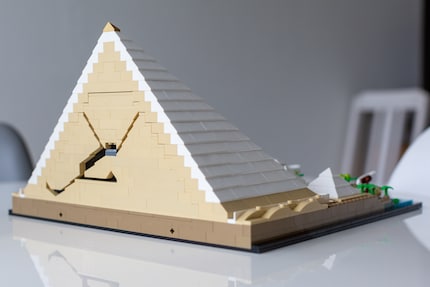
The lowdown
The pyramid is a beautiful diorama and a model full of details. The colours and shapes in the «front garden» make the set come to life. The smooth, white stones of the pyramid provide an exciting contrast. The dimension of the set, however, I find strange. It’s quite a bit larger than previous sets from the Architecture series and smaller than the buildings in the Creator Expert series. For fans who already own a decent collection of buildings, it could prove tricky to find space for the pyramid.
In addition to Lego fans, the pyramid is also suitable for another target group. While previous Architecture sets focused primarily on the final result, building the pyramid is also about gaining knowledge about that period in time. The assembling process tells a story. This could be interesting for school teachers. Being a wee wannabe archaeologist back in my schooldays, I would’ve loved if my history teacher to construct the set with me.
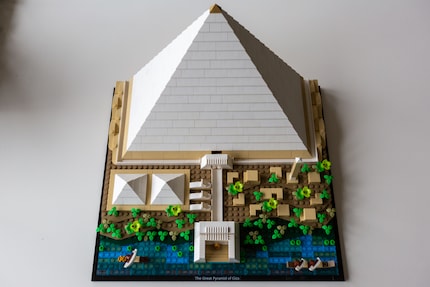
I get paid to play with toys all day.


